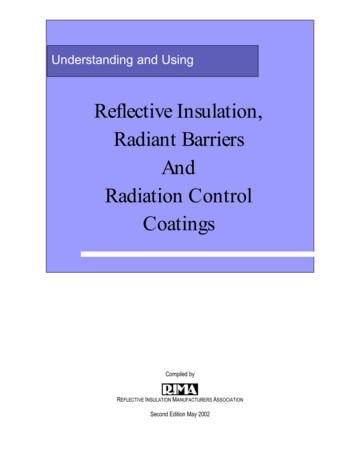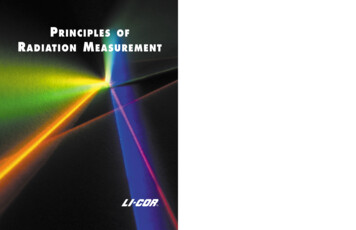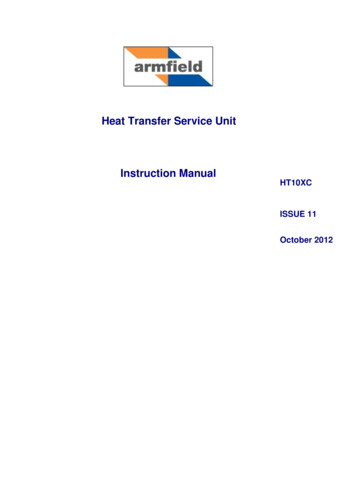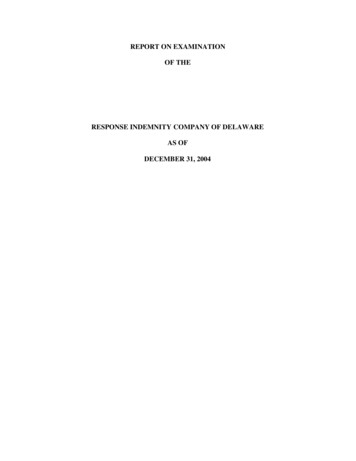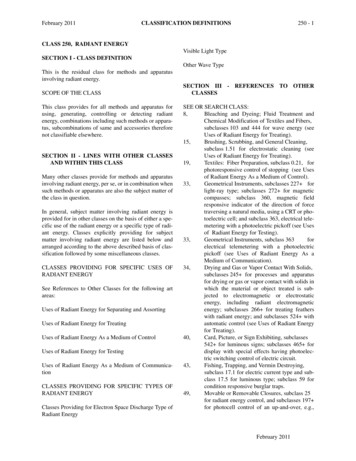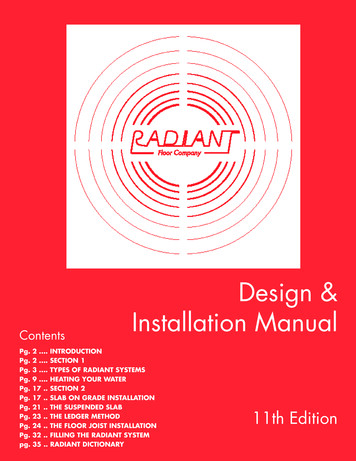
Transcription
ContentsPg.Pg.Pg.Pg.Pg.Pg.Pg.Pg.Pg.Pg.pg.2 .2 .3 .9 .17 .17 .21 .23 .24 .32 .35 .Design &Installation ManualINTRODUCTIONSECTION 1TYPES OF RADIANT SYSTEMSHEATING YOUR WATERSECTION 2SLAB ON GRADE INSTALLATIONTHE SUSPENDED SLABTHE LEDGER METHODTHE FLOOR JOIST INSTALLATIONFILLING THE RADIANT SYSTEMRADIANT DICTIONARY11th Edition
IntroductionThis installation manual is written in two sections. The first part contains a general overview of radiant heat and it’svarious applications. All the necessary components of a well-engineered and efficient hydronic radiant floor system areexplained in a straight forward and non-technical manner. The second section gets down to the nitty gritty details ofactual radiant floor installations. After reading this manual, you should have a clearer understanding of why radiant heatis considered the most efficient, cost-effective method of providing your home or business with state of the art heating.SECTION 1Getting Heat Into Your HomeRadiant heat is actually an old technology. It’s commonknowledge that the ancient Romans used it to heat theirpublic baths. In more modern times, the Europeans haverelied upon radiant heat for over 60 years. In fact, it wasservicemen returning from World War II who first spreadthe word about underfloor heat to their fellow Americans.Many radiant floors, most using copper tubing buriedwithin concrete slabs, were installed and used successfully in the 1960’s and 70’s. But they all suffered fromone primary problem .longevity. Copper within concrete is highly susceptible to corrosion and a lifespan of50 years for a radiant floor was considered exceptional.Today, modern plastics not only share many of the heatemitting properties of copper, but also provide greater flexibility, corrosion resistance, and a lifespan of over 100 years.Of these modern plastics, cross-linked polyethylene is byfar the best and most commonly used material. Below isa photo of our most versatile and highest output tubing.With 7/8” XL PEX you can expect a heat output of atleast 50 BTU’s per foot in a slab on grade installationand 40 BTU’s per foot in a floor joist application. It ispotable and ultraviolet resistant for protection againstsun damage during installation.7/8” Durapoly XL PEX (standard and O2 barrier)The 7/8” Durapoly XL PEX is a large diameter tubingwith the same wall thickness as the commonly used 1/2”PEX. It’s main advantage over 1/2” PEX lies in the factthat it holds more fluid, and consequently, more heat.It has a slightly lower temperature and pressure ratingthan 1/2” PEX, but it can be spaced as far apart as 16”on center and still heat a room insulated to modern standards (R-19 walls, R-27 ceilings). It would take twice asmuch 1/2” PEX to do the same job.That makes 7/8” ID PEX the first choice for any application where it can be feasibly used. It is ideal for joistsbays spaced 12”, 16”, or 24” on center, or virtually anyslab on grade installation. It is the only cross-linked 7/8”PEX tubing on the market and its bending diameter isless than 20”, making it easy to thread through floorjoists. This flexibility factor makes 7/8” PEX much lessprone to kinking than other 7/8” PEX tubings. Also,minimum tubing is required to gain maximum heatingresults. That saves money on materials and time.The 1/2” ID PEX is also a polyethylene tubing with avery high temperature and pressure rating (180 degreesat 100 psi). It emits about half the heat of the 7/8” PEX,but its bending diameter is tighter. Using 1/2” PEX forsmall zones, tight crawl spaces, or snowmelt applicationsmakes sense. It has a bending diameter of 15” and shouldbe spaced 8” to 12” on center.Various other types of tubing such as rubber, soft copper,polybutylene, or even plain, so-called “High DensityPolyethylene” (not cross-linked) are used for radiantheat. But the limited longevity of rubber, the difficultyand expense of installing copper, past problems withpolybutylene, and the tendency of plain polyethylene toshrink and crack in high temperature applications, makePEX the tubing of choice.What is Cross-Linking?1/2” PEX1/2” PEX( O2 Barrier)2According to the Radiant Panel Association, cross-linkingis: “a three dimensional molecular bond created withinthe structure of the plastic which dramatically improvesa large number of properties such as heat deformation,abrasion, chemical and stress crack resistance. Impactand tensile strength are increased, shrinkage decreasedand low temperature properties improved. Cross-linkedtubes also have a shape memory which only requires the
addition of heat to return it to its original shape whenkinked”.There are three types of cross-linking: electron, peroxide,and silane. Radiant Floor Company’s 7/8” PEX tubingis cross-linked with the electron process. It’s the cleanest,most environmentally friendly of the three methods. Ifyou’re interested in a more detailed technical explanation of the various cross-linking processes, try this lic/articles/details.cfm?id 14”If you’d like to see a graphic demonstration of howcross-linked Polyethylene differs from non-cross-linkedPoly tubing, see the photos below.Types of Radiant SystemsIt’s obvious that PEX tubing is the current industry standard. The question now becomes: What is the best wayto send heated fluid through the tubing to heat my floor?There are three main methods.Of course, as with all construction projects, consult withyour local building department to guarantee conformitywith local codes.The Open SystemThis system uses one heat source, your domestic waterheater, to provide both floor heating and domestic hotwater. The two systems are basically tied together. Thesame water that ends up in your hot shower or dishwasher,for example, has passed through the floor first. This is avery efficient system because one heat source is doing allthe work. As long as the water heater is sized appropriatelyand matches your heating and domestic requirements, theneed for a “separate” heating system is eliminated.Why is cold water entering the radiant system from thedomestic supply?The tubing on the left is black because the Polyethylenecontains a 2% carbon element for ultraviolet protection.The milky tubing on the right is a 7/8” ID “natural”High Density Polyethylene. It is not cross-linked, nordoes it contain the pigment necessary for ultravioletresistance. The 7/8” XL PEX in the middle is both crosslinked and UV protected.The Oven TestThe cross-linking process greatly increases the pressure and temperature characteristics of the Poly tubing.When all three tubes were subjected to 30 minutes of250 degree temperatures, only the PEX survived theexperienceLooking at the open system schematic you’ll notice thatcold water from your domestic supply enters the waterheater via the floor tubing. We plumb the radiant systemthis way so that there’s never any chance of stagnant waterentering your domestic system. Fresh water enters thetubing every time you use hot water.And although it looks at first glance as if cold water will becooling down your floor, in reality that won’t happen. Theonly cold water that can enter the tubing will be the “makeup” water to your water heater. If no hot water valves areopen in your domestic system, the radiant system is essentially “closed”. In other words, cold water cannot enterthe system unless it has somewhere to flow.an open hotwater valve in the house somewhere. Without an open hotwater valve, only the circulator pump supplying the radiant tubing can force water from the water heater into thetubing, and back, when your zone calls for heat.So, when you use hot water, cold water enters the waterheater via the floor. This assures that fresh water canalways flow through the system, even in the summer. Keepin mind that any hot water displaced by the cold make-upwater eventually works it’s way to the water heater, so there’sno net energy loss. And due to the large thermal mass in thefloor, the small amount of cold make-up water entering thetubing has no chance of cooling down the floor.unless ofcourse you were to take a four hour shower. That’s not likely.Also remember that if the thermostat in the zone is calling3
for heat at the same time you’re using hot water,then the circulator pump will still be pumping hotwater through the loops and the net result will bewarm water entering the tubing instead of cold. Bythe way, one of the easiest and least expensive waysto protect components in open systems, to say nothing of the home’s plumbing fixtures, is through theuse of a whole house filter. Common canister-typehousings are available at any hardware store and a20 micron filter will effectively remove silt and otherparticles from the home’s incoming water.No. That’s because our circulators are very low wattage, non self priming pumps. They can stir wateraround a radiant system, but they can’t compete withnormal domestic water pressure. As a result, domestichot water uses always take precedence.The Closed SystemBut if the radiant circulators are running, will thefloor steal hot water from my shower?SINGLE ZONE OPEN SYSTEMUsing On-Demand Water HeaterThree zone closed systemRR-D-T MUNIPUMPTO FLOORSHUTOFFHOT TOHOUSE028024040o120160COLD ONTANKFROM 250160200FROM FLOORTO HEAT SOURCEPrimary LoopOPEN SYSTEMUsing Tankless Water HeaterTo Zones Hot toSystemColdInReturns from floorNEVER SHORTENTHESE PIPES Secondary loop* Pre-assembled5 zone manifoldHot toHouse Fo Pump MixingValvePrimary loop o F PressureReliefValve 4 ShutoffValveTemperatureGauge psi PressureGauge*Pre-assembledOpen Primary Loop Pkg. Large, high volume radiant heatingsystems require Primary/Secondaryplumbing. The down side is two heat sources. All waterheaters waste heat energy, even when the burneris off and the unit is sitting idle between heating cycles. Granted, the unit dedicated to heating the floor only wastes heat during the wintermonths. But standby losses for six months outof every year can add up. The other consideration is efficiency. Two low or moderately efficient water heaters are much more costly to runthan one high-efficiency unit.TemperatureGauge psi250402400350300This approach utilizes a dedicated heat sourcefor the radiant floor. The fluid in a closedsystem is re-circulated around and around ina completely closed loop. There is no connection whatsoever to the domestic water supply.The main advantage to this system lies in thefact that, being closed, anti-freeze instead ofwater can be used as the heat transfer medium.The percentage of Propylene Glycol anti-freezeis determined by the type of heat source (ondemand heater or tank type) and by the guidelines listed on the anti-freeze container. Closedsystems are often used in second homes or primary residences in areas prone to long poweroutages. If freeze protection is an issue, than aclosed system with anti-freeze is a good idea.TakagiRadiant floors, one or several zones, are oftenadded to existing hot water baseboard or castiron radiator systems.
When using a tank-type water heater for a heatsource, no mixing valve is required.5
Adding a single radiant zoneto an existing boiler is easywith our pre-plumbed andpre-wired “Radiant Ready”installation PERATUREGAUGEFROM FLOORTO ROLMIXINGVALVEEXPANSIONTANKTAKAGIFROM HEATSOURCE0280240AIR ELIMINATORSINGLE ZONE SYSTEMUsing On-Demand 200FILL/DRAIN VALVETO HEATSOURCEIN-LINESTRAINERTAKAGI CLOSED SYSTEMEPK (detail)AirEliminatorPGPressuregaugeT2T1To second floor To first floor radiant slabAZELRELAYMULTIPLE ZONE SYSTEMUsing On-Demand WaterHeaterTGZone ManifoldTakagi remoteFrom baseboard unitCOLDTG6EPK1“ mixing valveFrom floorHOTPGTAKAGIPressurereliefvalve
Some do-it-yourselfers create art with our installation packages. The above example uses a Takagion-demand water heater to provide both domestichot water and four zones of space heatingOver a mile of 7/8” PEX was installed in thefloor of this state of the art dog kennel in northern Vermont. A 50 gallon, 199,000 BTU/hr.,Polaris water/space heater powers a four zoneopen system and provides the kennel’s domestichot water .all at 95% efficiency!7
Heat Exchanger Systemw/ multiple 0120160EPKHotToHouseVMIXVTakagiHOCOLD TStrainerOne 0200EPK (detail)PressureGaugeVDrain/FillValveAir EliminatorPressureReliefValve psi ShutoffValvePressureGaugeExpansionTank8Pressure TemperatureReliefGaugeValve
The Heat Exchanger SystemThis system uses an efficient heat exchanger to separatethe potable domestic water supply from the floor’s antifreeze mixture. Only one heat source is used and the benefits of freeze protection can be fully utilized.However, always ask yourself, “Do I really need a heatexchanger?”Most often heat exchangers are used for freeze protection,but another application would be a radiant system with oneheat source that, for one reason or another, must be separated from the domestic water supply. This is rare. Eventhe need for freeze protection is often overrated because aradiant system stores so much heat in the mass of the home.A heat exchanger system using anti-freeze can protect theradiant heating system down to –60 below zero. But thetrade-off is efficiency. Transferring heat from one mediumto another (in this case, from potable water to anti-freezevia the heat exchanger) costs BTU’s. The heat exchangeritself becomes warm and radiates into the surrounding air,though sometimes this heat helps warm a living space even if that space is only a utility room. Quite often,the heat exchanger is insulated to minimize this effect.Nevertheless, any heat radiating from the heat exchangeris thermal energy that could have gone to your floors.In addition, anti-freeze as a heat transfer medium is inferior to plain water. Overall, a heat exchanger system is 10to 20% less efficient than an open system.Of course, water has a nasty habit of freezing at temperatures below 32 degrees and in some situations this reality far outweighs the negatives of using a heat exchanger.Heating a second home in a remote location proneto power outages would be a perfect profile for a heatexchanger system. In this scenario, you can drain thedomestic water system if you leave for weeks in the winterand the anti-freeze protects the heating system.Heating a remote building may be another example. Ifyou’re sending water through a buried insulated pipeabove the frost line, anti-freeze is essential.Solar collectors almost always use anti-freeze, so a heatexchanger is necessary in this application also.The important point to understand is that most of thetime heat exchangers are not essential in a radiant system.Heating Your WaterSo what is the easiest, most efficient way to make hotwater? The answer depends upon your needs. If the combined requirements of both your domestic hot water andspace heating needs are less than 300,000 BTU’s then adomestic water heater can do the job. Just remember thatnot all water heaters are created equal. Some are specifically engineered for domestic and space heating applications. A water heater purchased from your local hardwarestore may very well do the job as long as your BTUrequirements are low. But the cost of running such a unitmay be alarming. Until recently the efficiency rating ofmany water heaters has been as low as 60%. That meansthat a full 40% of your fuel costs are going up the fluestack. The long-term result is enough wasted money topay for a high-efficiency water heater .but you won’town one! It’s always better to search the market for thebest water heater you can afford and size it for your heating requirements.On the other hand, if your home uses a combination ofbaseboard radiators and radiant heat, a situation common toretrofit projects, a boiler is your best bet. Boilers are designedto deliver lots of heat energy. They heat relatively smallamounts of water to very high temperatures and vary in sizefrom about 100,000 BTU’s to as high as you want to go.Other options include indoor and outdoor wood boilers,ground source heat pumps (sometimes called geothermalheating systems), electric boilers (if electricity in yourregion is inexpensive), and increasingly, on-demandwater heaters.Unlike standard, tank-type water heaters, on-demandunits eliminate “standby loss” by heating water onlywhen you need it. This feature can save up to 10% on fuelcosts because standard water heaters leak heat to the surrounding air 24 hours a day. Electronic ignition eliminatesthe wasteful pilot light common to standard water heaters.In addition, the latest models of on-demand heatersare condensing units. That means they condense thefuel (Natural gas or Propane) down to a trickle of watervapor, extracting 95% of the fuel’s energy to heat thewater. This efficiency translates to very low exhausttemperatures, so these units now vent with 3” PVCpipe. That not only eliminates the need to buy expensive stainless steel exhaust pipe, but it makes installationmuch easier. On-demand heaters are also lightweight,install in tight spaces, provide limitless hot water, andthe most sophisticated brands, like Takagi, monitor inletwater temperature and modulate the heater’s burnerup or down for maximum energy efficiency. A digitalremote displays incoming and outgoing temperatures,flow rate, flashes error codes for troubleshooting, andallows the user to set the unit for a variety of differenttemperature settings. Maintenance is simple – basicallythe fine mesh inlet screen should be checked periodically9
and kept clean. Note: New installations may requiredaily cleaning until soldering flux and minor debrishave been screened from the system.Fuel SourcesRadiant floors are heated by every heat source known. TheBrietenbush Resort in Oregon pumps water from natural hotsprings through their floors. The rest of us probably aren’t solucky and end up using gas, oil, solar, geo-thermal, wood, orelectricity to heat our water.As long as the water flowing through the tubing is a steady temperature between 120 and 135 degrees, the method of heating itis up to the homeowner.However, a few guidelines are important. Primarily, recoveryrate should be given great consideration. Natural gas, propane,oil and wood offer the highest recovery rates. To show theimportance of recovery rate, imagine this scenario.When the heated fluid in a radiant system satisfies the room’srequirements, the circulator pump shuts off. After a short time,the fluid cools down to room temperature. Some time later,when the room again calls for heat, many gallons of 70-degreewater flood the water heater. This can have the effect of “diluting” the overall temperature of the heating system. Normally,this is not a problem because most water heaters can raise thetemperature of the water very quickly.But this is not the case with tank-type electric water heaters.They are efficient in the sense that most of the energy going intothe unit becomes hot water. But the electric heating elementsdon’t do their job quickly. The radiant floor system basicallylimps along with 90 or 100 degree water as the elements struggleto raise the water back to the desired temperature level.So, if you live in a region of the country where electricity is socheap that heating water is feasible, consider investing in an electric boiler. Unlike a tank-type electric water heater which heats ahigh volume of water (30 or more gallons), electric boilers heata very small volume of water (1 or 2 gallons), and as a result, canprovide a consistent high temperature output.needs. More realistically, a modest “starter” system consisting oftwo or more absorbers can still supply an important boost to thehome’s conventional heating system. The basic mechanical components (pumps, heat exchanger, controls, etc.) remain the sameregardless of how many collectors may be added later.A realistic, long term view is important with solar. Granted, thesun begins paying back the investment every time it strikes thecollector. But sometimes when you really need the heat, it won’tbe there. Even Arizona, New Mexico, and Puerto Rico havecloudy periods. Even a full day of sun on the winter solstice willprovide only a weak, short solar opportunity.But during the spring, summer, and fall, an abundance of energywill flood your collectors. During these seasons on a good sunnyday, even a modest solar array can provide 100% of the home’shot water needs.So, what type of collector should be used?Most people are somewhat familiar with standard flat platesolar collectors. This collector is basically a highly insulated boxcontaining a grid of copper pipes bonded to a flat black copperabsorber plate. Special glass enhances solar absorption.Evacuated tube collectors are an entirely different approach to solarwater heating. Instead of many water filled copper pipes, thesecollectors use multiple vacuum filled glass tubes, each with a tinyamount of antifreeze hermetically sealed within a small centralcopper pipe. When heated by the sun, this antifreeze converts tosteam, rises to the top of the tube, transfers its heat to a collectorheader, then condenses back into liquid and repeats the process.Because thermal energy doesn’t easily transfer through a vacuum,92% of the thermal energy hitting the absorber plate stays withinthe evacuated tube and passes to the collector header. This is ahuge advantage because a standard flat plate collector radiatesmuch of its accumulated heat to the surrounding atmospherelike any other hot object.Solar water heaters often enhance radiant floor systems. Normally, a large solar heated storage tank (with gas, oil or woodbackup) supplies hot water to the radiant system and most oftenprovides for domestic needs as well.The evacuated tubes are also completely modular. Althoughrarely necessary, one or more tubes can be removed and replacedwithout affecting the other tubes in the array. There is noactual liquid transferred from the evacuated tube to the collector header.just heat. Evacuated tubes also start absorbing heatearlier in the day than flat plates due to their convex design andthe tiny amount of antifreeze within the tube is freeze protecteddown to -50 degrees below zero.Solar heaters interface well with radiantly heated floors because thelarge thermal mass common to radiant systems provides an excellentstorage medium for the energy generated during the day. At night,this stored thermal energy is slowly released into the living space anda steady, even, and consistent comfort level is maintained.The schematics on page 11 illustrate two ways solar can beincorporated into a radiant heating system. For a detailed discussion of solar thermal systems, as well as some photos ofcomplete installations, visit the “System Types” page of ourwebsite and click on “Heating with Solar Energy”.But sizing a solar heating system isn’t a simple matter. Latitude,solar orientation, budget, heat loss, type of collector, domestic hotwater requirements, esthetics, and performance expectations areall factors needing careful consideration. With unlimited funds,a roof covered with collectors can provide 90% of all hot waterFrom the Heat Source to the FloorHeating Water With Solar Energy10We’ve seen that virtually any method of heating water willwork for radiant floors and that PEX tubing is the best heattransfer medium. So, how do we spread that heated fluid tothe living space?
Hot to house Cold inSupply to floor Shut-offControllerSolarArray 110 VAC F psi o Sensor F 3/4"unionsReturn from floor TemperatureGaugeDrain/FillValveSwingTypeCheckValve o Takagi(back-up)Ground mounted solar11
ZoningUnless a heated area is very small, it will likely be brokenup into several “zones”. A zone is any area controlled bya single thermostat and supplied by a single circulatorpump. A zone can be tiny or huge. A zone can consist ofmany “circuits” or “loops” of tubing, or can be a singlecircuit. Circuit lengths should not exceed 400’ of tubing,but a zone may contain any number of circuits.So, the question becomes: How many zones do I need?The answer depends upon your lifestyle, the size of yourheated space, and the unique architectural characteristicsof the building.As a rule, keep zoning to a minimum. There’s nothingwrong with treating an entire floor as one zone. By onefloor, we mean one elevation. The first and second storyof one home shouldn’t share a single zone. So, if you havea two story house, your system will be a minimum oftwo zones.Minimum zoning is important because radiant heating isvery even. You are warming, not only the floor, but everyobject in the room. As a result, the entire space tends toequilibrate. Treating every room in the house as a separate zone is not only a waste of time and money, but itwon’t give you much control over a space that tends toseek the same even temperature.Zoning entire sections of a floor makes more sense. Ablock of rarely used bedrooms could be on their ownzone, for example. Also, many people prefer to maintaintheir master suite at a cooler temperature than the rest ofthe living space. If there’s a lifestyle reason to maintainone section of a given floor at a noticeably warmer orcooler temperature, then zoning is appropriate.Another example would be architectural features likesunrooms or great rooms with lots of glass. These roomshave a heat signature unlike the rest of the living space.During the day, a sunroom can be 20-degrees warmerthan the living room. If the thermostat controlling thezone is located in the living room, the sunroom willreceive heat it doesn’t need.The reverse is also true. High glass areas give off lots ofheat at night. Trying to keep the sunroom warm duringa cold winter night would overheat the rest of the livingarea if both spaces shared the same zone. Of course, itgoes without saying that window shades greatly reducenighttime heat loss in high glass areas and should beinstalled whenever possible.12Multiple CircuitsIf a zone can be any size, and each zone uses only onecirculator pump, how far can the hot water travel beforeit loses all its heat?The answer depends upon the size of the tubing used. Thesmaller ½” PEX is limited to a 300 ft. run, the 7/8” PEXto about 400 ft. So, if a zone is large enough to requiremore than, say 400 ft. of 7/8” PEX, the heated area mustbe broken up into multiple circuits, all approximately thesame length. Similar lengths are important because younever want to give the water a “path of least resistance”to follow. If your zone consisted of three circuits, one200 ft. long, and two 100 ft. long, the two shorter circuits would steal the water from the longer 200 ft. circuitbecause they would offer the pump less resistance. Aninefficient heating system would result.This is how it should be done:For example, let’s say that your entire first floor is oneevenly heated space, one zone. You need 1200 ft. of 7/8”PEX tubing, spaced 16” on center, to cover the wholearea. If you tried to run the hot water continuouslythrough 1200 ft. of tubing, you’d end up with ice waterby the time it got back to your heat source. Instead, youcan break up the zone into one of these configurations:(6) 200 ft. circuits(4) 300 ft. circuits, or(3) 400 ft. circuitsYou can see that none of the circuit lengths has exceeded400 ft. In each case, the water is returning to the heatsource before or at the 400 ft. point.Keep in mind also that these circuit lengths are justexamples. A circuit length should conform to each individual situation. The installer can be flexible within theabove guidelines. If you are installing tubing in yourfloor joists, and you determine that the ideal circuitlength for your situation would work out well as (5)240 ft. circuits then by all means do it that way. (Seesection 2, The Floor Joist Installation, for detailed installation instructions.)The Zone Manifold(See Diagram on page 15)A tank of efficiently heated water won’t do much heating unless it can be distributed effectively to the zones.
For this we use a Zone Manifold. This is simply a factory built manifold containing all the gauges, valves,pump flanges, etc. (see illustration page 15) necessaryto mount multiple circulator pumps in one central location. It’s normally installed very near the heat sourceso that any pump, when activated by a signal from thezone, can draw hot water and send it to the floor. If forsome reason, the Zone Manifold is not located within6 feet (3 feet for on-demand units) of the heat source,the pipe size between heat source and manifold shouldbe increased in direct proportion to the distance. Contact one of our technicians for specifics and never use anypiping material except copper to connect the heater to theZone Manifold, i.e. never use PEX, PVC, ABS, blackiron, or garden hose for this purpose.Every zone always has its own circulator pump. That way,the pump can be sized to match the amount of tubingin the zone. The fluid from the pump then enters thesupply line to the zone, travels through the floor, thenreturns to the heat source.pipe. This is because you are already in copper pipe modewhen you leave the circulator pump.Getting from copper pipe mode to PEX tubing moderequires a brass fitting called an adaptor.As the need arises, the installer can “adapt” from a coppersupply line to the PEX tubing, or adap
ing of the home’s plumbing fixtures, is through the use of a whole house filter. Common canister-type housings are available at any hardware store and a 20 micron filter will effectively remove silt and other particles from the home’s incoming water. But if the radiant circulators ar



